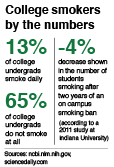Smokers find safe haven on smoke-free campus
March 10, 2015
A year after the introduction of the University’s smoke-free policy, smokers find new places to smoke off campus property.
The smoke-free policy went into effect on Jan. 1, 2014. According to the Campus Recreation website, the policy is “providing a healthy learning environment for students and a healthy work environment for faculty and staff.”
But the University is not the only campus enforcing a smoke-free policy; as of Jan. 1, there are at least 1,514 smoke-free campuses in the country.
In addition, the McKinley Health Center offers various guides to help smokers quit, along with smoking cessation programs and free “quit kits.”
“Typically, policies like this that make it inconvenient for people to use tobacco are a big encourager for people to quit,” said Nikki Hillier, the program coordinator at the Champaign-Urbana public health district.
Get The Daily Illini in your inbox!
Hillier organizes smoking cessation programs at the center, encouraging wellness and health promotion. The class involves a seven-week, eight-session class helping community members and University faculty go through the quitting process with the support of others.
“We have definitely seen more calls to the tobacco quit line in the past year,” Hillier explained. “But a lot of people quit smoking on their own.”
A University student, who prefers to remain anonymous, has been smoking cigarettes since he was 14. By the time he was 20, he was smoking a pack of cigarettes a day.
“When you’re 18 years old, addiction seems like something that you have time to beat, but it’s definitely smarter to nip such addictions in the bud, and I can guarantee that the longer you have been smoking cigarettes, the more difficult it is to stop,” he said. “My freshman year, I became used to being allowed to smoke before classes, and especially before tests and midterms, which was when they really helped me relax the most.”
After the enforcement of the new policy, the student said it was hard to find places near his classes to smoke. Over time, it became more and more difficult for him to continue the habit, so he recently quit smoking.
“Every smoker knows that what they’re putting into their body isn’t good for them, and it would be in their best interest to quit,” he said. “I think that the no-smoking rule on campus definitely did play at least a small role in my quitting, in that I was not able to stand directly outside my class buildings anymore and smoke cigarettes before going inside. This led to me smoking farther and farther away from my classes, and when I was running late to class, smoking was no longer something that I could afford to do.”
But other smokers on campus find new places to smoke, despite the policy’s attempt to stop it.
For example, the Chapel of St. John the Divine, located at 1011 S. Wright St. in Champaign, provides such a location for smokers on its property.
“I thought it was better to be hospitable than to be hostile,” said Father Sean Ferrell, the rector at St. John’s. “I was the one who made the policy, so basically the church has been a place where people have smoked previously and when the University made the smoking ban on the Urbana campus, they communicated to the religious groups that they should follow their lead and ban smoking also, and (we) declined their offer.”
Some University employees and students take advantage of the smoking space that the church provides.
“It was a student vote, and none of us are students,” said Gerry Stigberg, an employee of the library. “The students who voted are probably long gone, but we’re still here. People have found their places to smoke. We’re fortunate that we can just walk across the street.”
Bob Deremiah is also an employee of the University who is taking advantage of the church’s hospitality.
“Smokers need rights too, and we’re losing our rights — slowly but surely,” he said in between puffs of his cigarette. “We really appreciate the church for letting us use this area. It’s really nice of them, because the University really put a lot of pressure on them to not let us do it and they chose to look the other way.”
Ferrell explained that although he is not a smoker, he believes that when smoking outside, others do not have to deal with the smoke, and therefore allows smokers to find comfort at the church’s front steps. Many are extremely appreciative toward the church for their resilience against the University.
“We got a thank you card the other day that had 35 to 40 signatures and money in it,” Ferrell said.
Soud Alrashed, junior in LAS, is an international student from Kuwait, and explained that smoking in his home country is less “legislated against” than it is here.
“What do I think about the nonsmoking rule? Look at this!” he said as he inhaled through his cigarette’s filter. “Every Monday, Wednesday and Friday at this time you can find me right here. I’m a regular.”
Alrashed also described the location as a “haven” for smokers. Any church on campus could allow people to smoke on its property because it is private property.
“Personally, the rule has just made me go around it. People still smoke on campus. It also seems like the rule isn’t enforced very strongly,” said Samuel Lee, sophomore in LAS, who has been smoking since he was 17. “The University’s rule has impacted me slightly — I am unable to smoke on my way to class, which is a slight inconvenience, but there are sanctuaries for smokers right by the Main Library.”
Daniel Martin, a building service worker at the Undergraduate Library, agreed the rule is not strictly enforced.
“Police can’t enforce it, because it isn’t a law,” he said. “The hard-core smokers are going to smoke their whole lives.”







